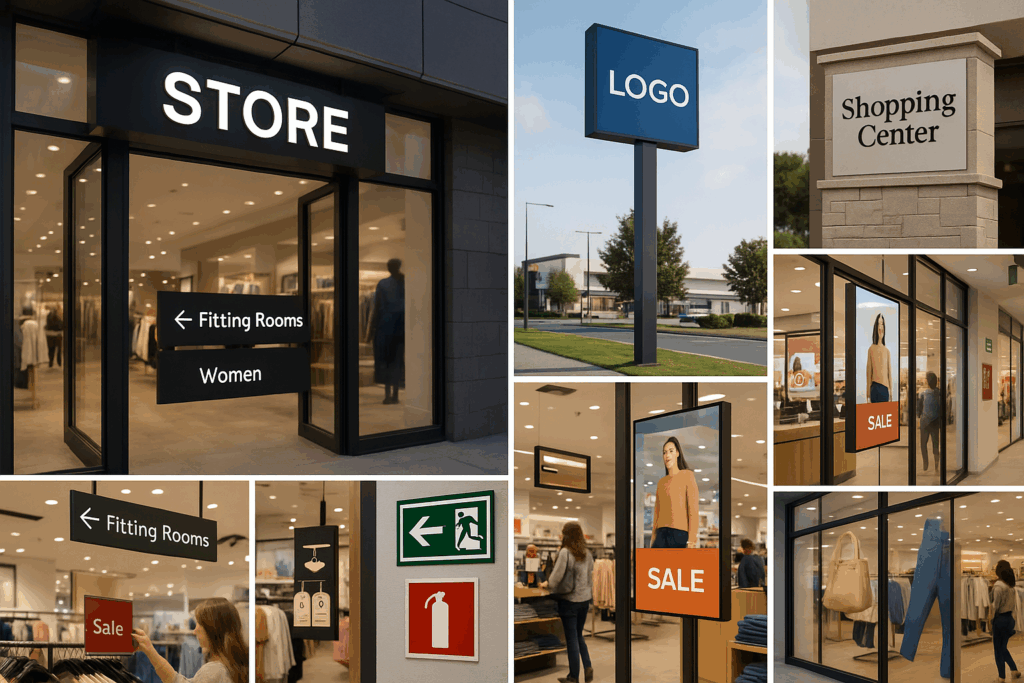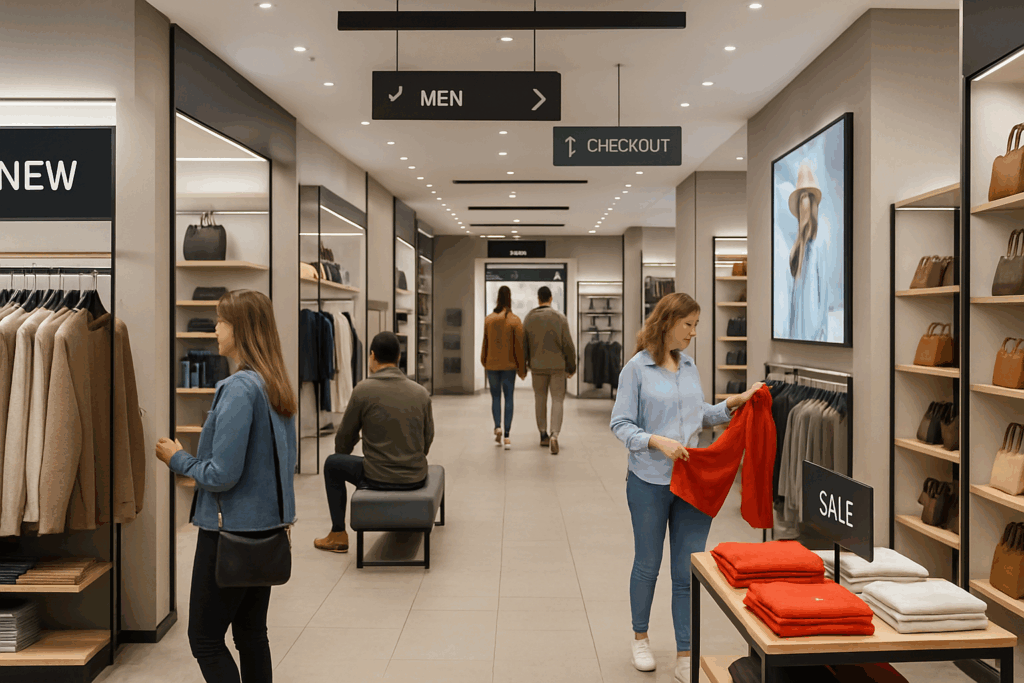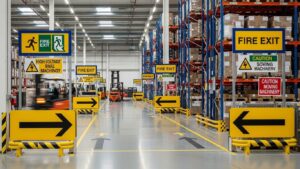Think about walking into a shop with clear, bold signs showing offers and directions. Now, think of another store with no signs and a confusing interior. Which store would you stay longer in? The answer is easy; the one with better signs.
Retail signage does more than decorate your store. It helps people notice your brand, guides them inside, and even makes them buy more. A 2024 survey revealed that 76% of shoppers entered a store because of its signs. Another study found that types of retail digital signage can increase sales by 32% and improve brand recall by 55%.
These numbers show that using the right types of retail signage is not just about looks. It helps you attract, guide, and convert customers, making it a must for any retail store.
What Is Retail Signage and Why Does It Matter?
Retail signage refers to all the visual displays used in and around your store. These include name boards, sales tags, direction signs, and more. The goal is to guide, inform, and influence people without needing to talk.
Signs do more than tell people where things are. They create the feel of your store. They help define your brand and improve your customer experience. Good signage saves your staff time by answering common questions visually.
Studies show that clear signs increase impulse buys by 70%. That means signs not only help people but also boost your sales. The right signs act like silent workers who guide, inform, and promote your business all day.

Types of Signage in Retail Stores
There are many different types of signage in retail. Each one has a job to do and helps in its own way. Below are eight important types every retail store should know and consider using.
Storefront Signs
Your storefront sign is the first thing people see. It introduces your shop to the world. Most shoppers decide whether to enter a store just by looking at the signs outside. A strong storefront message includes your brand name, logo, and hours of operation. It also helps your store stand out on a busy street or in a shopping area.
Pylon Signs
Pylon signs are tall, independent signs that are seen from a distance. You tend to find them in front of malls, shopping plazas, or gas stations. These signs are convenient for businesses along highways or where a lot of foot traffic is coming from a distance. They guide people toward your store even before they reach the area.
Monument Signs
These signs are built low to the ground and often made from solid materials like stone or concrete. Monument signs offer a high-end, professional look. Businesses in office parks, gated communities, or retail complexes use them to show long-term presence and reliability. They send a message of trust and stability to your audience.
Wayfinding Signs
Wayfinding signs assist individuals in navigating the store. If your store is large or consists of many sections, such signs eliminate confusion. They direct customers to departments, restrooms, or checkouts. When customers know where to go, they linger longer and purchase more. Research even shows that proper navigation can boost shopping time by 18%.
Interior Signs
Interior signs include things like price boards, sale signs, or product descriptions. These signs keep customers informed as they shop. They help you control how people move and what they focus on. For example, placing signs near high-margin items can push sales without extra effort. Interior signs are also great for improving product visibility and supporting brand recall.
Digital Signs
Digital signs are screens used to show videos, offers, or menus. These are flexible and easy to change. If you have new promotions or special deals, you can refresh digital signs immediately. Research indicates that digital signs can result in 25% more impulsive purchases. This is why they suit areas of high activity, such as entrances, checkouts, or waiting areas. Among all types of retail signage, digital options allow the most control over time-sensitive messages.
Safety Signs
Safety is important in every store. Safety signs remind people where exits, fire extinguishers, or restricted areas are. These signs are also legally required and must follow HSE and OSHA rules. Besides keeping customers safe, safety signs also protect your business from risks. They show responsibility and build trust with your visitors.
Wall and Window Graphics
These signs are placed on walls or glass panels. They help you use empty space in a creative way. Wall graphics can show your story, while window signs highlight offers or new arrivals. This is one of the easiest ways to make your store look busy and interesting from outside. Many businesses try new shop sign ideas using this type of signage to attract walk-ins.

How Signage Improves In-Store Experience
The right signage helps people move smoothly through your store. Signs reduce confusion and help customers focus on products. When customers can find what they need quickly, they enjoy shopping more.
Signage also helps promote specific products. You can guide people toward high-margin items or new collections. Reports show that well-placed signs improve product interaction by over 30%.
Consistent signs across the store also build brand identity. When customers keep seeing the same colors, style, and tone, they remember you better. It builds long-term trust and improves repeat visits.
How to Choose the Right Sign Type for Your Store
Picking the right signage depends on your store’s size, layout, and customer type. Small shops may not need tall signs, but large stores benefit from wayfinding and digital displays.
Think about your audience. Are they walking by? Then use a bold storefront sign. Are they driving? Choose a pylon sign for visibility. Use clear messages that match your brand tone and style.
Mix digital with physical signs when possible. This lets you share both real-time updates and lasting messages. Always keep your signs readable. More than 83% of customers say that poor readability makes them skip products or even leave stores.
Also, test different spots and styles. Watch how people react. Use their feedback to improve your signage over time.
Bringing Your Retail Signage Strategy Together
To build an effective signage strategy, keep your brand and customers in mind. Signs should match your store’s voice and layout. Update them regularly to match seasons, trends, or customer habits. Use fresh shop sign ideas and be open to change. Ask customers what works for them. If something doesn’t catch attention, try a new design or placement.
Use simple tools like heat maps, foot traffic counters, or POS systems. These help you see how signs affect customer movement and buying decisions. Over time, this data helps you improve your sign strategy without guessing. A smart sign plan is not just about design; it is about results.
Conclusion
Signs do much more than just decorate your store. They attract, guide, and influence your customers every day. With the right types of signage in retail, your store becomes easier to explore and more enjoyable to shop in.
From a bold storefront sign to modern digital displays, every sign tells a part of your brand story. In places like Cheshire, where competition is strong, attractive signage helps you stand out. The right mix of signage supports both brand growth and customer satisfaction. Invest in your signs wisely. Let them work for your brand; day in or day out.Want to upgrade your signage? Let us help you design signs that truly speak to your customers.





